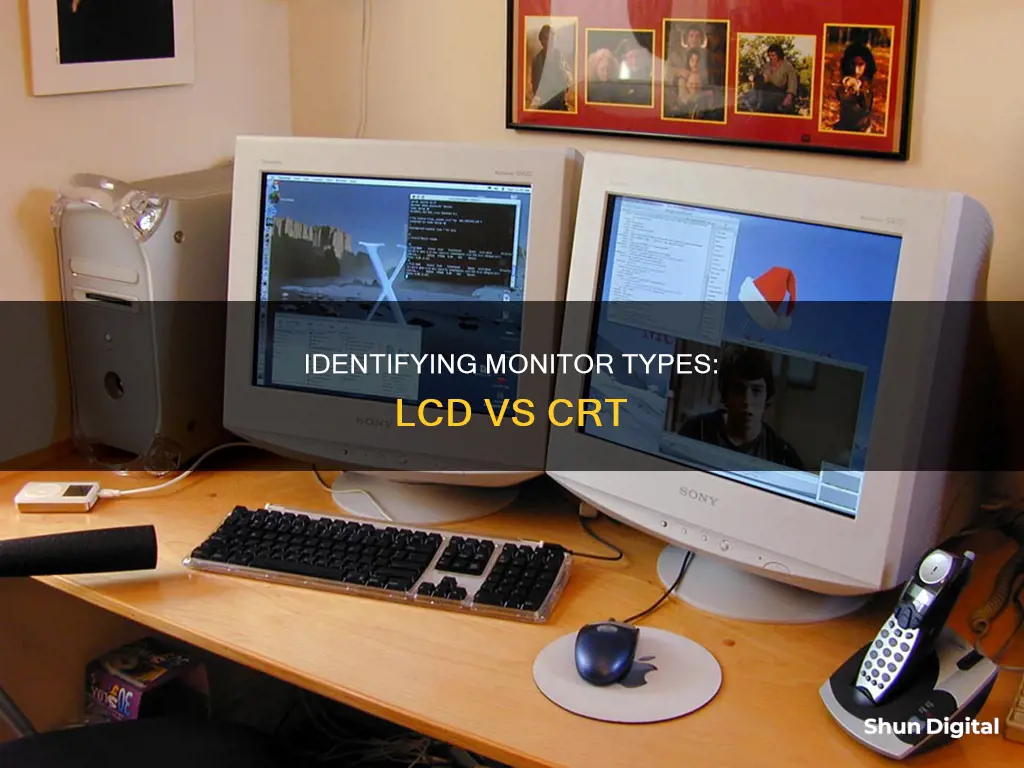
There are two primary types of computer monitors: LCD (Liquid-Crystal Display) monitors and CRT (Cathode Ray Tube) monitors. CRT monitors are older and bulkier, while LCD monitors are newer, more compact, and more lightweight. CRT monitors offer better colour clarity and faster response times, but LCD monitors are more energy-efficient, produce less glare, and have a larger viewing area.
What You'll Learn

CRT monitors are heavier and bulkier
CRT monitors, or Cathode Ray Tube monitors, are heavier and bulkier than their LCD (Liquid-Crystal Display) counterparts. CRT monitors are considered outdated and are no longer in production, with modern LCD monitors being the current standard. The bulkiness and weight of CRT monitors are among their most significant drawbacks, making them less convenient and appealing than LCD monitors.
The weight of a CRT monitor can vary depending on its size, with larger screens requiring thicker glass to withstand the vacuum pressure inside. The glass used in CRT monitors is typically leaded glass, which is denser and stronger than regular glass. This thick, lead-infused glass is necessary to block X-ray radiation from the electron beam and to prevent violent implosion due to the vacuum inside. As a result, the bigger the tube, or screen, the heavier the monitor.
A CRT monitor can weigh 40 pounds or more, while an LCD monitor of a similar size can be up to 80% smaller in total mass. For example, a 30-inch CRT TV can weigh around 150 pounds, whereas a 50-inch plasma display will weigh only about 100 pounds. The weight distribution in CRT monitors is typically towards the front, where the screen is located, making it feel even heavier when lifted.
The bulkiness of CRT monitors also poses challenges in terms of space and transportation. They are much larger than LCD monitors, often awkwardly taking up valuable desk space. Their weight and size make them difficult to move around and limit their market appeal, especially in corporate offices or data centers.
In summary, CRT monitors are heavier and bulkier due to the thick, leaded glass required to withstand vacuum pressure and block X-ray radiation. This weight and bulkiness make CRT monitors less convenient and appealing than modern LCD monitors, contributing to their decline in popularity.
Monitoring Verizon Data Usage on Your Galaxy S7
You may want to see also

LCD monitors are more compact and lightweight
When it comes to choosing a computer monitor, there are two primary types in use today: LCD (Liquid-Crystal Display) monitors and CRT (Cathode Ray Tube) monitors. LCD monitors are more compact and lightweight than their CRT counterparts, offering several advantages for users.
One of the most notable features of LCD monitors is their slim and sleek design. LCD monitors are much thinner than CRT monitors, typically measuring only a few inches in thickness. This makes them ideal for small spaces and tight areas where a bulky CRT monitor would not fit. The compact size of LCD monitors allows for easy handling and transportation, making them a convenient option for those who need to move their monitors frequently.
In addition to their slim design, LCD monitors are also significantly lighter in weight. While a CRT monitor can weigh 40 pounds or more, LCD monitors are much lighter, typically weighing between 8 and 10 pounds. This weight difference makes a substantial impact on portability and ease of installation. With an LCD monitor, users can avoid the hassle and bulkiness often associated with CRT monitors.
The compact and lightweight design of LCD monitors provides users with greater flexibility in terms of placement and setup. LCD monitors can easily be mounted on walls or adjusted to fit in limited spaces. This versatility is especially beneficial for those with smaller workspaces or those who require multiple monitors in their setup. The ability to customize and arrange your workspace according to your needs and preferences is a significant advantage offered by LCD monitors.
Furthermore, LCD monitors provide a larger viewable area compared to CRT monitors of the same diagonal screen size. This means that LCD monitors can offer a more expansive display without taking up additional space. This is particularly advantageous for users who require a large screen area for tasks such as design work or gaming. With an LCD monitor, users can maximize their screen real estate without sacrificing desk space.
Another benefit of LCD monitors is their energy efficiency. LCD monitors consume less power than CRT monitors, resulting in lower electricity costs over time. This not only saves money but also makes LCD monitors a more environmentally friendly option. For those conscious of their energy usage and carbon footprint, LCD monitors present a more sustainable choice.
In conclusion, LCD monitors offer a range of advantages due to their compact and lightweight design. Their slim profile, light weight, and energy efficiency make them a convenient, flexible, and environmentally friendly option for users. With LCD monitors, users can enjoy a modern display technology that is easier to handle, transport, and integrate into their workspace.
iPhone X Display Size and Dimensions Explained
You may want to see also

CRT monitors have better colour rendering
CRT (Cathode Ray Tube) monitors are considered outdated since their production has halted due to cost and environmental concerns. However, they do offer certain advantages over LCD monitors, with one of the primary benefits being superior colour rendering.
CRT monitors provide better colour clarity and depth, making colours appear more vibrant. This is because CRT monitors have better contrast ratios and colour depth than LCD screens. The enhanced colour rendering of CRT monitors is particularly important for graphic designers, who require accurate and vivid colour representation for their work.
While LCD monitors have improved over the years, CRT monitors still offer greater colour clarity. The superior colour rendering of CRTs is due to their ability to display a wider range of colours, or colour gamut. This is especially noticeable when comparing older LCD screens to CRT monitors, as the former often struggled to match the NTSC colour requirements.
However, it is important to note that the colour quality of CRT monitors can degrade over time as the phosphors in the tube break down. Additionally, LCD monitors have other advantages, such as compact size, lightweight design, reduced eye fatigue, and more environmentally friendly construction.
Despite these advantages of LCDs, some users, particularly those interested in digital art and graphic design, still prefer CRT monitors for their superior colour rendering capabilities.
Monitoring Data Usage: Net10 Mobile Hotspot Guide
You may want to see also

LCD monitors are more energy-efficient
LCD monitors are thinner and lighter, making them easier to handle and transport. They are also more environmentally friendly, using significantly less energy than CRT monitors. A 19-inch LCD monitor, for example, consumes only about 17 to 31 watts on average, whereas a 17-inch CRT monitor can use up to 80 watts. This difference in power consumption makes LCD monitors a more cost-effective and eco-friendly choice.
The energy efficiency of LCD monitors can be attributed to their design. They do not have a glass screen, which helps eliminate glare and reduces the need for higher brightness settings. Additionally, LCD monitors have a constant screen display of pixels being on or off, resulting in lower intensity lighting that is easier on the eyes and requires less power.
While LCD monitors excel in energy efficiency, they do have some drawbacks. One of the main disadvantages is the issue of dead pixels, which can cause small black or colored dots to appear on the screen. LCD monitors may also suffer from reduced color clarity and motion blur on fast-moving images. However, despite these shortcomings, LCD monitors remain the preferred choice due to their compact size, lightweight design, and energy efficiency.
In conclusion, LCD monitors have become the standard for modern computing due to their energy efficiency, ease of use, and versatility. With improvements in technology, LCD monitors continue to offer enhanced performance while consuming less power, making them a more sustainable option for consumers and the environment.
Unlocking G-Sync: Updating Your ASUS Monitor to G-Sync 10
You may want to see also

CRT monitors are cheaper
CRT (Cathode Ray Tube) monitors are cheaper than LCD (Liquid-Crystal Display) monitors. This is due to several reasons, including production, demand, and the availability of newer technology.
Firstly, CRT monitors are cheaper because they are no longer in production. The manufacturing of cathode ray tubes has halted due to cost and environmental concerns, making CRT monitors outdated. As a result, they are readily available on the second-hand market, often for very low prices or even given away for free.
Secondly, the demand for CRT monitors has decreased significantly. With the introduction of LCD monitors, which are thinner, lighter, and more energy-efficient, most consumers opt for the newer technology. This shift in demand has further driven down the prices of CRT monitors.
Additionally, the increasing popularity of LCD monitors has made them the standard in the market. Their compact size, lightweight design, and ease of transportation have contributed to their higher demand. The newer technology offers improved features such as a bigger viewable area, reduced glare, and the elimination of burn-in issues, making them more desirable to consumers.
It is worth noting that CRT monitors do have certain advantages over LCDs, such as better color rendering, higher refresh rates, and the ability to scale to various resolutions without losing picture clarity. However, these advantages are often outweighed by the convenience and improved features offered by LCD monitors.
In summary, CRT monitors are cheaper than LCD monitors due to a combination of factors, including the discontinuation of production, lower demand, and the availability of newer, more desirable technology. While CRT monitors may offer certain benefits, the advantages of LCD monitors, along with their widespread adoption, have driven down the prices of CRT options.
Monitoring Hotspot Usage: A Guide for Samsung Note 8 Users
You may want to see also
Frequently asked questions
LCD monitors are thin, like a digital watch or a notebook screen, and can usually be picked up with one hand. CRT monitors are bulkier and will always be more than a couple of inches from the viewing surface to the back end.
LCDs are thin and flat like modern TVs, whereas CRTs are curved and bulkier.
It depends on your use case. CRT monitors have better contrast ratios and higher refresh rates, so content looks richer and deeper. However, LCD monitors are newer and more widely used.
Sony Trinitron, Mitsubishi, Hitachi, LaCie, NEC, Iiyama, and Eizo.
Most CRT computer monitors have a VGA video input. Some late-model CRTs support a version of DVI-A or DVI-I, and older CRTs from the 1980s might use a composite input.







